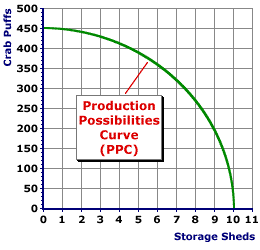
|
|
TAX BASE: An item or activity that is subject to taxation. The most common tax bases are income, consumption, and wealth. The personal income tax and Social Security tax are two common taxes levied on the income base. Sales taxes are the most common taxes levied on the consumption base. Property taxes are the most common taxes levied on the wealth base.
Visit the GLOSS*arama
|
|


|

|
                           FULL EMPLOYMENT: The state that occurs when all of the economy's resources are engaged in the production of output. In practice, an economy is considered to be at full employment when the unemployment rate is around 5 to 5 1/2 percent and the capacity utilization rate of capital is about 85 percent. This is one of the five economic goals and three macroeconomic goals. Full employment is achieved in principle when all available resources (labor, capital, land, and entrepreneurship) are used to produce goods and services. This goal is commonly indicated by the employment of labor resources (measured by the unemployment rate). However, all resources in the economy--labor, capital, land, and entrepreneurship--are important to this goal. The economy benefits from full employment because resources produce the goods that satisfy the wants and needs that lessen the scarcity problem. If the resources are not employed, then they are not producing and satisfaction is not achieved.Graphical Indications| Production Possibilities |  | Aggregate Market |  |
Full employment plays in important role in several graphical analyses. The two most common are the production possibilities model and the aggregate market model (or AS-AD analysis).- Production Possibilities: Full employment is indicated by the boundary of the production possibilities frontier. The production possibilities frontier is constructed under the assumption that all available resources are engaged in production of two goods. As such being on the frontier is, by definition, tantamount to full employment.
- Aggregate Market: Full employment is indicated by the position of the long-run aggregate supply curve. The long-run aggregate supply curve is constructed based on the assumption that flexible prices have adjusted to achieve equilibrium in all markets. Most important, resource markets are in equilibrium, with quantities demanded equal to quantities supplied. In other words, for the labor market, the number of jobs available matches the number of workers available.
Natural UnemploymentFull employment is usually equated with natural unemployment, which is the amount of unemployment consistent with an expanding, growing economy that has no inflation. This is usually considered the combination of structural and frictional unemployment, but no cyclical unemployment. Historical evidence indicates that a 5 to 5 1/2 percent unemployment rate meets these conditions. If the unemployment rate drops much below 5 to 5 1/2 percent, then the inflation rate increases, suggesting that the economy is trying to produce more output than it is capable of doing. However, some contend that full employment exists at a higher unemployment rate, while others argue that a lower unemployment rate is correct. The Politics of Full EmploymentThe macroeconomic goal of full employment would seem to be universally acknowledged as a beneficial pursuit. That, however, is not necessarily the case. At the very least, some are extremely passionate about achieving full employment. Others might even find full employment somewhat objectionable.Consider the two basic political philosophies--liberals and conservatives. - Liberals: Those who comprise the working class and occupy the lower end of the income spectrum, tend to favor the pursuit of full employment more than most. They are the ones most likely harmed by unemployment and thus to benefit from full employment. Liberal politicians count these folks among their core constituency.
- Conservatives: Those who own businesses and are on the employer side of labor markets tend to be less inclined to think full employment is a beneficial state of the economy. Because everyone already has a job, full employment makes it more difficult and costly to hire new workers. A little bit of unemployment tends to make hiring easier. Conservative politicians count these folks among their core constituency.

Recommended Citation:FULL EMPLOYMENT, AmosWEB Encyclonomic WEB*pedia, http://www.AmosWEB.com, AmosWEB LLC, 2000-2024. [Accessed: October 30, 2024].
Check Out These Related Terms... | | | | | | | |
Or For A Little Background... | | | | |
And For Further Study... | | | | | | | | |
Search Again?
Back to the WEB*pedia
|



|

|
BLACK DISMALAPOD
[What's This?]
Today, you are likely to spend a great deal of time driving to a factory outlet seeking to buy either a large, stuffed kitty cat or a cross-cut paper shredder. Be on the lookout for letters from the Internal Revenue Service.
Your Complete Scope
This isn't me! What am I?
|

|
|
Approximately three-fourths of the U.S. paper currency in circular contains traces of cocaine.
|

|
|
"Anyone who has never made a mistake has never tried anything new. " -- Albert Einstein, physicist
|

|
PV
Present Value
|

|
|
Tell us what you think about AmosWEB. Like what you see? Have suggestions for improvements? Let us know. Click the User Feedback link.
User Feedback
|


|


